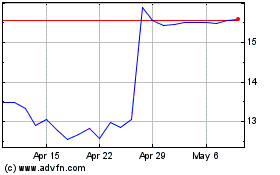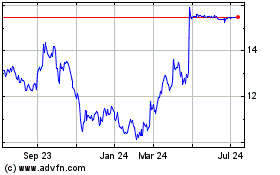2nd UPDATE: Frac Sand Miner U.S. Silica Trades Down Post-IPO
February 01 2012 - 4:52PM
Dow Jones News
The sand used in oil and gas well fract7uring didn't cause much
excitement among investors Wednesday, with shares of U.S. Silica
Holdings Inc. (SLCA) declining on their first day of trading.
The company's stock closed at $16 on the New York Stock
Exchange, down 5.9% from its initial-public-offering price of $17.
A total of 11.8 million shares were sold at the midpoint of its
$16-to-$18 price range.
Two other offerings expected to begin trading Wednesday,
biopharmaceutical developer Merrimack Pharmaceuticals Inc. and oil
and gas production company Dynamic Offshore Resources Inc., were
postponed after failing to price Tuesday night.
U.S. Silica specializes in commercial silica--essentially,
sand--that is used in a variety of industries, the most prominent
being oil and gas. The company's "frac sand" is used to stimulate
oil and gas wells that are in shale formations, and it claims to be
one of the few commercial producers capable of rail delivery of
large quantities of the material to each of the major U.S. shale
basins.
Strong demand for frac sand has led U.S. Silica to invest in
expanding its production by 75% over 2010 levels and to build a new
facility that makes resin-coated sand, another area of market
growth. The company plans to use a portion of its IPO process to
help build the facility and to fund future capital spending at the
firm.
Demand for the company's IPO was said to be strong ahead of the
launch, and company President and Chief Executive Bryan A. Shinn
said the offering was well oversubscribed, with an enthusiastic
reception from attendees at road shows.
"We think a lot of (the stock's initial trading performance) has
to do with technical trading issues," said Shinn during a telephone
interview with Dow Jones. "We believe it was well-priced in the
middle of the range. The stock is not something we are going to
watch on a minute-by-minute basis."
U.S. Silica is the second-largest domestic producer of
commercial silica, and while frac sand accounts for nearly half of
its business, the company also makes silica for glassmaking,
chemical manufacturing, solar panels, wind turbines, specialty
coatings and geothermal energy systems.
U.S. Silica says it has a low-cost operating structure because
it owns most of its sand reserves and locates its processing
facilities close to its mines. It expects demand to rise for its
frac sand as more horizontal wells are drilled using fracturing
techniques, well length increases due to advances in drill
technology, and more frac sand is used per foot.
Silica prices increased at an average annual rate of 9% between
2000 and 2009; if demand for frac sand continues to rise, and if
the general economic recovery continues to result in increased
demand from other industries, U.S. Silica expects prices to go even
higher.
In the first nine months of 2011, sales increased 14% to $212
million, and profit more than doubled to $20 million.
The company's growth through frac sand isn't without its risks.
If oil prices contract, high-tech hydraulic methods to drill wells
in shale may prove too expensive, and demand for frac sand would
fall. Other methods that use different materials to stimulate wells
could replace frac sand.
Three-quarters of U.S. Silica's IPO shares were sold by previous
owners, so the company won't receive those proceeds. The major
seller was private equity firm Golden Gate Capital.
Morgan Stanley (MS), Bank of America Merrill Lynch and Jefferies
Group Inc. (JEF) were joint bookrunners on U.S. Silica's
offering.
-By Lynn Cowan, Dow Jones Newswires; 301-270-0323;
lynn.cowan@dowjones.com
Silica (NYSE:SLCA)
Historical Stock Chart
From Jun 2024 to Jul 2024

Silica (NYSE:SLCA)
Historical Stock Chart
From Jul 2023 to Jul 2024
